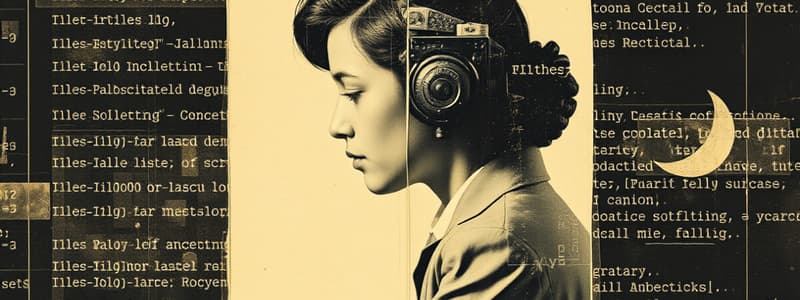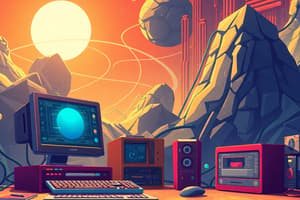Podcast
Questions and Answers
A computer program is a sequential set of instructions known as ______.
A computer program is a sequential set of instructions known as ______.
codes
The art and science of instructing computers to perform tasks is known as ______.
The art and science of instructing computers to perform tasks is known as ______.
programming
Programming languages allow programmers to write code using more ______ syntax.
Programming languages allow programmers to write code using more ______ syntax.
human-readable
Initially, programming involved writing ______ code which consisted of binary instructions.
Initially, programming involved writing ______ code which consisted of binary instructions.
The term 'paradigm' is synonymous with ______.
The term 'paradigm' is synonymous with ______.
A programming ______ defines the rules for valid statements in a language.
A programming ______ defines the rules for valid statements in a language.
An ______ is a software application that helps format, check, and run code.
An ______ is a software application that helps format, check, and run code.
An ______ is a program that converts high-level language instructions into machine-readable code.
An ______ is a program that converts high-level language instructions into machine-readable code.
An ______ is a set of steps designed to solve a specific problem in programming.
An ______ is a set of steps designed to solve a specific problem in programming.
The formula for the volume of a rectangle is volume = length × width × ______.
The formula for the volume of a rectangle is volume = length × width × ______.
Flashcards are hidden until you start studying
Study Notes
Programming Basics
- A computer program consists of a sequential set of instructions (codes) written in a programming language for the computer to perform specific tasks.
- Examples of software include system software, web browsers, utility software, multimedia software, and spreadsheet software.
- Programs are executed sequentially unless specified otherwise, conveying tasks that a programming language supports.
- A programming language is defined by grammatical rules that instruct a computer to perform functions or behaviors.
The Art and Science of Programming
- Programming involves creating codes that instruct computers on problem-solving and task execution.
- Skills in programming lead to diverse careers such as software development, web development, data science, and artificial intelligence.
- Developing programming skills enhances critical thinking, logical reasoning, and problem-solving abilities by breaking down complex tasks into smaller steps.
Evolution and History of Programming
- Initial programming was done using low-level machine code (binary).
- The advent of high-level programming languages simplified the coding process, making it easier to write human-readable syntax.
- Modern programming encompasses a wide range of languages and tools tailored to various programming paradigms and application needs.
Programming Paradigms
- A programming paradigm is a pattern for structuring and organizing code, providing a conceptual framework for problem-solving.
- Selection of a programming language depends on project requirements, performance, community support, and available libraries or frameworks.
Key Programming Terminologies
- Syntax: Rules defining valid combinations of symbols in a programming language.
- Command: Unique instructions given to a computer to perform tasks (e.g., “print”).
- Integrated Development Environment (IDE): Software for coding, checking syntax, and running code; may support multiple languages or be language-specific.
- Library: A collection of resources, such as functions and objects, usable individually but needing configuration to work together.
- Interpreter: A program executing high-level language instructions directly without conversion to machine language.
- Assembler: Converts assembly code into machine language.
- Compiler: Converts high-level language code into machine-readable format.
Algorithm, Pseudocode, and Flowchart
- An algorithm is a step-by-step set of operations leading to a solution for a problem and should be written in clear, understandable language.
- Example: To calculate the volume of a rectangle, input length, width, and height, and use the formula:
volume = length × width × height. - The problem-solving process includes problem analysis, algorithm design, coding, and execution.
Pseudocode
- A pseudocode is a simplified notation used to outline an algorithm's steps, making it easier for those with basic programming knowledge to follow.
- Common symbols in pseudocode include arithmetic operations, comparisons, assignment, and logical commands.
Flowchart
- A flowchart visually represents the steps of an algorithm using standard symbols to describe processes and decisions.
- Two categories of flowcharts: Program flowcharts (focus on software logic) and System flowcharts (show system interactions and data flow).
Flowchart Symbols
- Terminal: Represents start and end points.
- Input/Output: Indicates input or output operations.
- Computer Processing: Denotes processing actions.
- Decision: Shows where a decision is required to proceed.
Rules for Creating Flowcharts
- Use only standard symbols and show flow from top to bottom and/or left to right.
- Each symbol must have a single entry and exit point, except for decision symbols.
- Expression within symbols should be language-independent and decision branches should be clearly labeled.
Studying That Suits You
Use AI to generate personalized quizzes and flashcards to suit your learning preferences.




